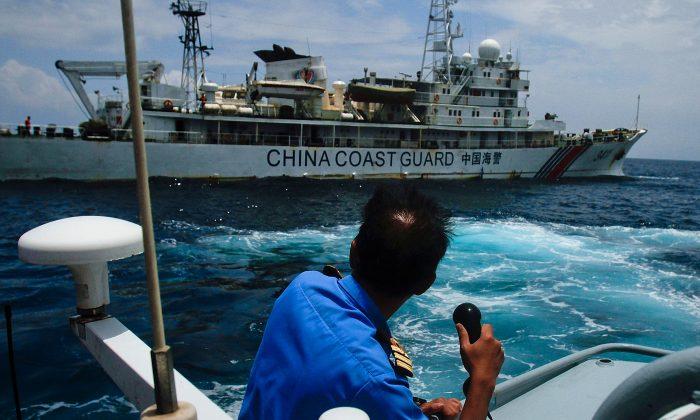The United States has finally put its foot down, facing the Chinese Communist Party’s (CCP’s) use of open deception to seize control of the South China Sea. The head of the U.S. Navy has allegedly told the CCP that hostile actions from its coast guard and fishing boats will be seen as no different than hostile actions of the Chinese navy.
Admiral John Richardson, head of the U.S. Navy, allegedly alerted his Chinese counterpart, vice-admiral Shen Jinlong, of the new standard in January.
To make a long story short, the CCP uses its fishing boats and coast guard ships as key pieces in its military strategy, designed to seize control of the South China Sea and nearby regions. The fishing ships even train alongside the Chinese navy.
Rather than just send in military ships, it started by sending in large numbers of fishing ships to contest the territory, then Coast Guard ships to “protect” them, then military warships, then it builds artificial islands to base the warships. These islands then become Chinese territory, used to expand the CCP’s borders and to declare ownership of the strategically important region.
The CCP has been open about this strategy, which CCP officials call the “cabbage strategy” designed to wrap areas up layer by layer until the CCP can seize control of it. The militarized fishing boats and coast guard ships are known as the CCP’s “maritime militia.”
Despite the fact that the strategy is openly discussed—and well understood in the West—the CCP has been able to carry it out due to loopholes in rules of engagement. By simply labeling ships used in military operations as fishing boats, or by painting warships as coast guard ships, the CCP has been able to manipulate international standards on engagement, and has prevented a harsher response from surrounding countries as it carries out its land-grab.
The fishing ships, meanwhile, have been extremely aggressive with foreign vessels, including Japanese and Philippine ships. This aggression allows them to chase out foreign presence so the CCP can operate uninhibited, as it gains control over the strategically important region.
The Japanese coast guard released a video in August 2016, showing 200 to 300 Chinese government and fishing boats, accompanied by Chinese coast guard ships, intruding on Japanese territory near the Senkaku islands. The CCP claims the islands are its historical territory.
A Plot in Broad Daylight
The South China Sea is a strategically important region. In addition to holding valuable undersea minerals, oil, and natural gas, it’s also a trade chokepoint for up to 40 percent of the world’s shipping.Yet, for the CCP, the strategy in the South China Sea goes further than just control of the shipping channels. It’s also part of the CCP’s area-denial, anti-access (A2/AD) strategy. After the CCP gains control of the region, and constructs its artificial islands, it uses this control to deny other nations access to the territory.
CCP military officials have been open with this. In February 2016, South China Morning Post published a story titled, “China’s military is prepared ‘to defend sovereignty’ in the South China Sea.”
“The island is thus wrapped layer by layer like a cabbage … a cabbage strategy has taken shape,” Zhang said, adding “For many things, we have to grab the right timing to do them.”
To militarize its fishing ships, in 2013 the CCP financed more than 50,000 fishing boats to install its Beidou satellite system (BDS) replacement for GPS, which the ships use to coordinate their operations with the military. Qi Chengye, a manager at BDStar Navigation, told the CCP’s Xinhua news outlet, at the time, “The government pays for most of the cost of the client terminals, and gives fishermen diesel subsidies according to the distance and frequency of their vessels heading out to sea.”
A Strategy for Deception
Behind the CCP military operations is its Three Warfares strategy of legal warfare, psychological warfare, and media warfare. It was approved for military use by the CCP’s Central Military Commission in 2003.Legal warfare works through manipulating national and international law for strategic use, psychological warfare aims to alter the way a target perceives information, and media warfare aims to control and influence the public release of information.
In the South China Sea, the CCP used legal warfare to make legal claims to the region. It eventually lost the legal battle, but then ignored the adverse ruling. It used psychological warfare to make public claims of “historical ownership” of the region. Then it used media warfare to rally domestic media and influence foreign media to spread its talking points.
The concept is simple: if a country offers protections for a free press, for example, they will create news outlets on your soil to attack you; if you say you believe in free speech, they will send agents to criticize you; if you don’t attack civilian ships, they will use civilian fishing boats for military operations, and so on. There are groups in China that study the laws and systems of each targeted country, and develop strategies to exploit these.
And these programs tie to the broader concept of the CCP’s overall warfighting concept, designed to first look at what the goal of war would be, then to strategize how it could be achieved using means outside conventional military conflict. This is the basis of its numerous unconventional strategies, including its “Unrestricted Warfare” programs for a war without morals, its Three Warfares strategy of deception, and its cabbage strategy of layered conquest.


![[LIVE 4/26 at 10:30AM ET] New Push Started for Global Digital Currencies](/_next/image?url=https%3A%2F%2Fimg.theepochtimes.com%2Fassets%2Fuploads%2F2024%2F04%2F19%2Fid5633115-0426-1080x720.jpg&w=1200&q=75)


